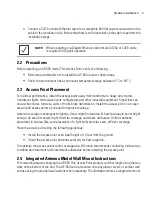
Hardware Installation
5
4.
Connect a CAT-5 or better Ethernet cable to a compatible 802.3af power source and run the
cable to the installation site. Ensure that there is sufficient slack on the cable to perform the
installation steps.
2.2 Precautions
Before installing an AP-650 model Thin Access Point, verify the following:
•
Motorola recommends not to install the AP-650 in wet or dusty areas.
•
Verify the environment has a continuous temperature range between 0° C to 50° C.
2.3 Access Point Placement
For optimal performance, install the access point away from transformers, heavy-duty motors,
fluorescent lights, microwave ovens, refrigerators and other industrial equipment. Signal loss can
occur when metal, concrete, walls or floors block transmission. Install the access point in an open
area or add access points as needed to improve coverage.
Antenna coverage is analogous to lighting. Users might find an area lit from far away to be not bright
enough. An area lit sharply might
minimize coverage and create
dark areas.
Uniform antenna
placement in an area
(like even placement of a light bulb) provides even, efficient coverage.
Place the access point using the following guidelines:
•
Install the access point at an ideal height of 10 feet from the ground.
•
Orient the access point antennas vertically for best reception.
To maximize the access point’s radio coverage area, Motorola recommends conducting a site survey
to define and document radio interference obstacles before installing the access point.
2.4 Integrated Antenna Model Wall Mount Instructions
This mounting requires hanging the AP-650 Thin Access Point along its width or length using the two
slots on the bottom of the unit. The AP-650 can be mounted onto any plaster, wood, or cement wall
surface using the provided wall anchors when necessary. The illustration shows a lengthwise mount.
NOTE
When operating in a Gigabit Ethernet environment CAT-5e or CAT-6 cable
is required for Gigabit operation.











































